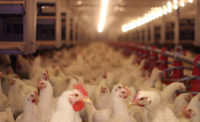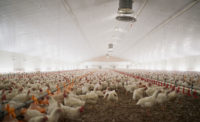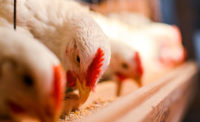Animal welfare
Farm to Plate: Consider a bird’s-eye view

Because birds perceive the world differently simply because of their eyesight, it is important that we make proper management decisions to positively affect their lives.





We are all observers of the world around us, drawing conclusions and cues from our environment. Animals are also observers, referring to their surroundings to determine their status based on the social cues they pick up. But what they see, hear and perceive differs from what we see, hear and perceive. Behavior always has a cause and reaction. Some of the causes might be something that we cannot see, such as something occurring inside the bird. Behaviors may be a direct correlation to something we did that caused their behavior to change. One major element with which we can influence bird behavior is our lighting system.
Seeing is believing
Birds rely heavily on vision in order to perceive, thrive and survive. Their vision is used for determining friend from foe, finding and foraging for food, and for mate determination. As a human, I tend to think that we have pretty good vision overall. Considering we are “predators,” based on our bipedalism and forward-facing eyes, we have about 1 million fibers in each optic nerve, for example. Put into the context of how birds see, at a conservative comparison, we only have approximately 40 percent of the fibers located in a single optic nerve in a bird.
A bird’s eyes comprise a large amount of their head in relation to the brain. They processes light similar to other vertebrates; however, they have a structure in their eyes called the pecten oculi, a specialized structure that nourishes the retina among other functions. This structure allows the retina to be avascularized, meaning it has few or no blood vessels. It is this combination of the avascularized retina and the pecten oculi that allow for the prevention of shadows and light scattering within the eye of the bird. This is extremely important in the depth perception and sharpness of their vision. Anyone who has experienced turkey hunting understands the importance of camouflage.
Where things get really interesting is in realizing how many different wavelengths birds can see. The visible wavelength spectrum for a human is around 390 to 700 nm wavelengths, or violet colors ranging up to red colors. Birds, however, can perceive light wavelengths down to a 310 nm, or the ultraviolet range. So, how do they do this?
Birds are able to see in the ultraviolet spectrum because of the way the bird focuses the image. Without going into too much detail, their optical image is spread over a larger retinal area and therefore, over a larger number of photoreceptors, giving them a sharper image and increased acuity, even in low light conditions. This gives birds a large advantage in low light conditions, such as an owl hunting at night. The tradeoff is that they are sensitive to high-intensity light. This brings me to the next bit of importance and why we should care.
Translating into behavior
Because birds perceive the world differently simply because of their eyesight, it is important that we make proper management decisions to positively affect their lives. Working with turkeys, it didn’t take me a long time to realize they usually will turn their body to orient themselves sideways. They do this so that they can use their lateral (side) field of vision to see you from a distance. However, it is important to remember that each type of bird’s ability to perceive various objects differs. For example, a falcon with sharp vision and the accuracy to determine the difference between two insects from a 60-foot tree within a half an inch of one another has different requirements than a turkey hen protecting her young poults from predators.
Because birds have adaptations that allow them to see in low light conditions, it is important as their caretakers to be conscious of the decisions we make in our everyday management practices. Light parameters such as intensity, photoperiod and wavelength all have an effect on bird performance. Some effects are positive gains, as seen by an increased feed intake during periods of time with increased levels of light or negative effects that impair the immune system and feed conversion ratio. While doing some further investigation as to what the “best” lighting practice is, of course, there was no “one solution” to solve the dilemma. However, LED lighting is trending in production and has shown both positive and negative effects. Therefore, I’ve decided to include a little information about it.
LED: The good, the bad and the ugly
Light emitting diodes, more commonly known as LED lights, are special because they are a source of monochromatic light, meaning they emit one wavelength of light. For example, LEDs emitting blue, green and yellow wavelengths have been shown to improve immunity and meat quality in broilers. Additionally, the use of blue and green light also promoted greater antibody production and function compared with a red LED. At first glance, it seems that once the proper wavelength is found, the birds will have the best production possible.
But keeping broilers under a yellow and green-blue mixture of light resulted in softer breast and drumstick muscles. So there becomes a trade-off that we have to be conscientious about depending on our breed, species and desired production output (meat, eggs and breeders). Remember to do what is best for your production processes, but keep in mind the welfare of the bird when choosing your lighting schedule and type.
Keeping up with the times
Just because Farmer Joe up the road has decided to install a 100 percent LED highly vigorous lighting schedule that is completely automated by a computer program and has upgraded his buildings does not mean that his ideas are the best. In my experience, a producer can have a 25-year-old building and produce better birds than the brand-new tunnel ventilated, highly computerized housing system. It all comes down to understanding the physiology of the bird and having the best management practices we can to ensure bird welfare.
Lighting is just one of the many aspects that allow us to produce a better bird. Based on how birds perceive light and environmental cues, it is important that we set forth our best management practices to ensure the comfort of the animals. In the end, farm-raised birds, such as chickens and turkeys, are prey animals. Their eyes have been designed for protection. So if we adjust the wavelength, type of bulb or amount of light the birds receive in a day, it is beneficial to know how their eyes function and aid them in distinguishing shapes from friend or foe. NP
Looking for a reprint of this article?
From high-res PDFs to custom plaques, order your copy today!












